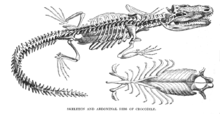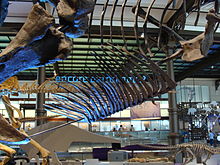Gastralium
Abdominal ribs are skeletal structures in the lower abdominal region that were common in theropods and are found in recent species only in crocodilians (Crocodylia) and tuataras (Sphenodon). Because of their location, abdominal ribs are also called gastralia (singular gastrale), ancient Greek γαστήρ gaster, German 'belly'. They are ventral remnants of dermal bone armor that are not connected to the rest of the skeleton.
The gastrial apparatus in Prosauropoda and lizard pelvic dinosaurs consists of eight to twenty metameric arch-shaped rows composed of four or, depending on the adhesion, fewer bones. A distinction is made between median (lying toward the middle) and lateral (lying at the edge) bones. In the case of median adhesion only three bones per row are present, and in the case of additional lateral adhesion only one. The latter is often the case with the cranial and caudal rows. The bones of a row and the rows among themselves may be connected in a joint-like manner; there is no connection to the rest of the skeleton.
Dinosaur gastralia were first described in 1838 by Eudes-Deslongchamps in Poekilopleuron bucklandii, but without being recognized as dermal bones. Therefore, Osborn's 1906 description of the gastralia of a Tyrannosaurus rex is often cited as the first description. After Osborn's rediscovery, gastralia were soon found in theropod and prosauropod taxa. In 1994, gastralia were also described in sauropods (Apatosaurus). Recent birds no longer have gastralia, but their predecessors such as Archaeopteryx or Confuciusornis do. Gastralia have also been described in the prehistoric bird Sinoris santensis. This archaically preserved feature seems to have no influence on flight or sitting posture, but is considered an additional clue to see theropods as the closest relatives of birds.
Traditionally, the gastralia are thought to protect and support the visceral area. As the sketch opposite illustrates, the gastralia could have been used to control the shape of the abdomen and thus support breathing. Today's bird breathing can possibly be traced back to this, as explained in the article Air sac (bird).
Gastralia are found in only a few recent species, the tuataras and the crocodilians. In crocodilians, pairs of curved bony spines are found on the ventral side, eight pairs in true crocodilians, seven pairs in alligators. These are not fused median, but are connected by connective tissue.

Gastralia of a crocodile

Cuirass respiration in theropods and early birds: A inspiration, B expiration. Spreading of abdominal ribs causes lateral widening or narrowing of the abdominal cavity. Ventral view. After Carrier & Farmer (2000).

Gastralia in Tyrannosaurus
Search within the encyclopedia